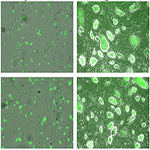A role for Egfl7 during endothelial organization in the embryoid body model system
Main Article Content
Abstract
Epidermal growth factor-like domain 7, Egfl7, is a largely endothelial restricted gene which is thought to have a role during the differentiation of embryonic stem cells (ESCs) along the endothelial lineage. While it has been shown that Egfl7knock-down in zebrafish impairs endothelial cord formation, the role of the gene in mammals has been unresolved. Interpretation of mouse knockout studies has been complicated by the fact that deletion of miR-126, an intronic microRNA located within Egfl7, results in vascular defects. Here we use an siRNA knock-down approach to target specific regions of Egfl7without affecting miR-126expression. Egfl7was knocked down in mouse ESCs and the effect on vascular development was assessed using the in vitroembryoid body (EB) model after either 7 or 14 days of differentiation. Knock-down of Egfl7resulted in the formation of abnormal sheet-like CD31+ structures that were abundant within EBs after 7 days of differentiation. Only up to 60% of these sheets co-expressed basement membrane and endothelial cell junction markers. Similar CD31+ sheets were also seen as outgrowths from 7 day EBs into collagen gels. A partial remodelling occurred by 14 days of differentiation when fewer CD31+ sheets were seen both within EBs, and as outgrowths from EBs. Formation of these sheets was due, at least in part, to increased proliferation specifically of CD31+ cells. Cell death within EBs was unaffected by Egfl7knock-down. In conclusion, our work shows that knock-down of Egfl7causes defects in early vascular cord formation, and results in the development of CD31+ sheet-like structures. This suggests that Egfl7is vital for the formation of endothelial cell cords, and that the gene has an important role during both vasculogenesis and angiogenesis in mammalian cells.
Article Details
How to Cite
DURRANS, Anna; STUHLMANN, Heidi.
A role for Egfl7 during endothelial organization in the embryoid body model system.
Vascular Cell, [S.l.], v. 2, n. 1, p. 4, feb. 2010.
ISSN 2045-824X.
Available at: <https://vascularcell.com/index.php/vc/article/view/10.1186-2040-2384-2-4>. Date accessed: 22 jan. 2026.
doi: http://dx.doi.org/10.1186/2040-2384-2-4.
Section
Original Research

